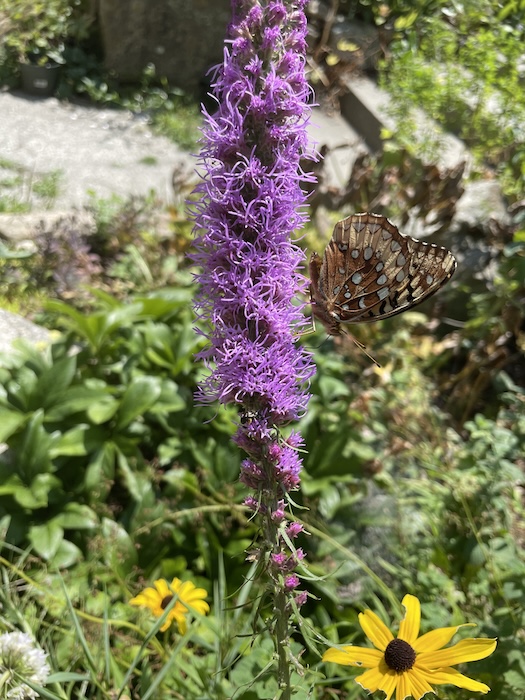Now that we’ve had a robust stretch of rainy days, I’ve noticed the wetter areas of the landscape again. These could be places where the stormwater pools for a few days before drying out, or bare spots in the yard where it’s so wet that the lawn doesn’t hold.
I love the opportunity to deploy the rain garden plants. These are species that don’t want to live in a wetland but are happy enough to sit in water for a spell. They can handle wet-to-dry conditions without faltering. Their root systems sustain them through a flow of water and keep them in place. Additionally, they look nice and can be combined to create a resilient and hard-working garden.
Woody plants
Winterberry (Ilex verticillata) — Part of the holly family, this partially evergreen shrub has dark gray bark graced with red berries covering its branches in winter, hence the common name. Birds flock to the berries and the diminutive flowers are beloved by pollinators and invite close observation. It’s lovely in every season and can grow in some shade or full sun and wet to moist soil. Give it space to reach its full height and width of 10 to 12 feet.
Sweetspire (Itea virginiana) — This shrub can also handle part-shade to full sun and will enjoy wetter soil conditions but also be fine with drier soil. It blooms from late spring into the summer with showy, white flowers that last for many weeks. Smaller than the winterberry at around 5 feet tall and wide, it can be used in many locations.
Pussy willow (Salix discolor) — Of all the native willows, this may be my favorite. I remember the soft catkins from my childhood, growing along stream banks with cattail rushes. This shrub will grow to 15 feet but can be kept shorter through pruning. It does best in full sun. It can do OK in part-shade, but let it thrive in a sunnier spot if you can. Its tolerance for soil moisture ranges from wet conditions to average, drier sites. Combine male and female shrubs to produce the showiest buds and fruit. Pollinators love it in the spring.
Perennials
Blue flag iris (Iris versicolor) — In a rain garden planting, the plants that tolerate the wettest soil, possibly standing water, are usually placed in the middle or lowest part of the basin. This iris is the right plant for those spaces. It spreads via rhizomes and has the tenacity to hold its place in moving water. The purple flowers show off in spring. It will do well in full sun or part-shade. I’ve noticed an outlier growing in nearly full shade around the pond in our woods, so maybe that’s OK, too.

Blazing star (Liatris spicata) — After the iris has finished, the blazing star will begin its display with purple flowers on a long stalk. The foliage of these plants is complementary, with similar leaf styles but different patterns.
Turtlehead (Chelone glabra) — To fill out the blooming section, this striking plant will be white in late summer and fall, completing the cycle for pollinators and viewers. It’s best in part-shade but can handle more sun if the soil stays moist or it is well-mulched with leaf litter. The flowers are like a snapdragon, or a turtle’s head (naturally).
Grasses
Wood’s sedge (Carex woodii) — This sedge (sedges have edges, rushes are round) received top ranking in a long-term Carex species trial by the Mt. Cuba Center, a Delaware botanical garden that specializes in native plants. It’s versatile and can handle sun and shade, dry and wet. Sedges can be filler plants interspersed among other perennials as groundcover or, with one this attractive, the main event.
Switchgrass (Panicum virgatum) — This stately, clump-forming, warm-season grass is as aesthetically pleasing in winter as in other seasons and keeps the garden from feeling bare. At 3 to 5 feet, it can excel in dry conditions as well as in wetter. There are a few cultivars, such as Northwind, commonly available in nurseries.
Little bluestem (Schizachyrium scoparius) — I plant this grass frequently because it is so versatile and brings loveliness wherever it goes. Try it in dry, wet, clay, well-drained or poor soils — basically anywhere but sand. It will stay upright in sun and flop a bit in shade but never disappear. I was warned that it would spread aggressively, but I haven’t seen that behavior after many years of planting. I wish it would, though.

